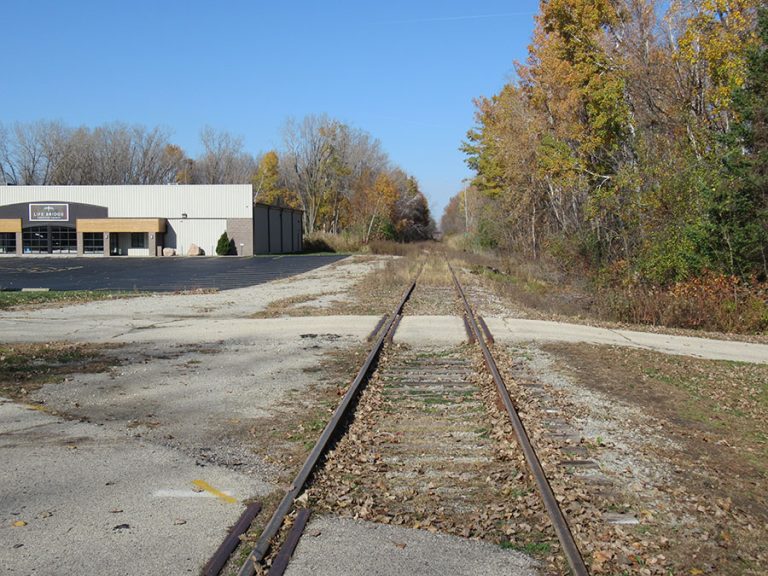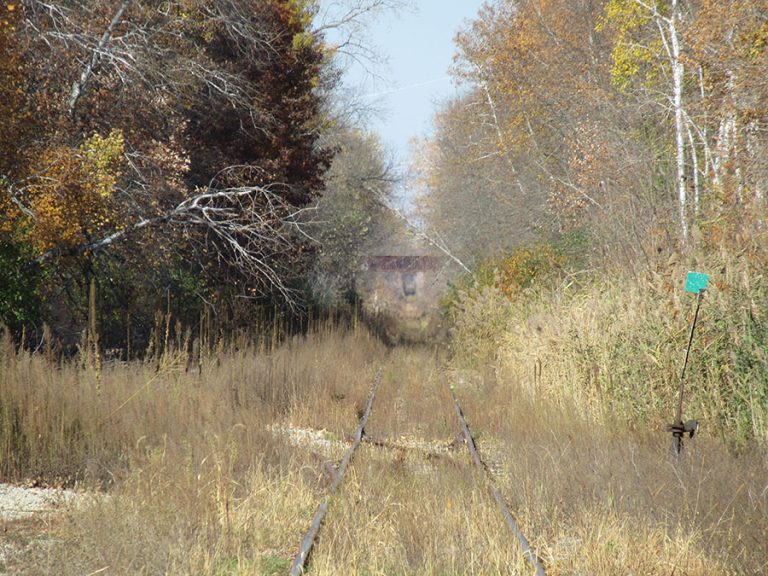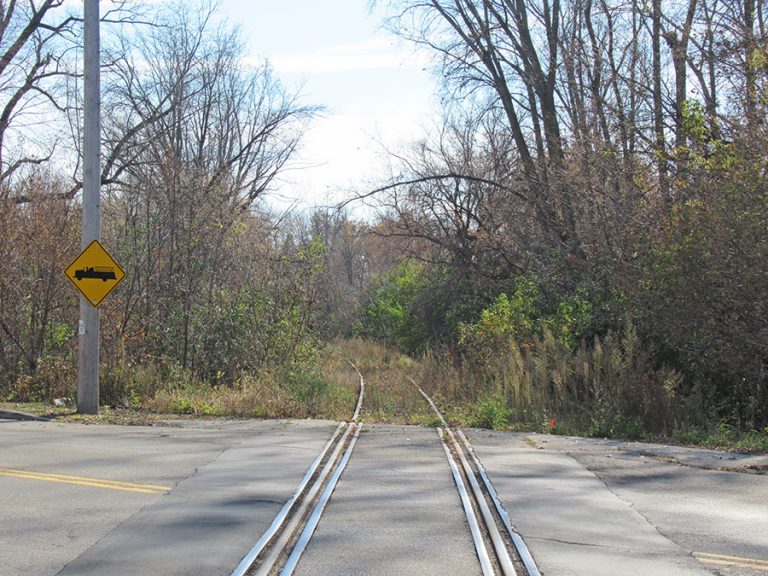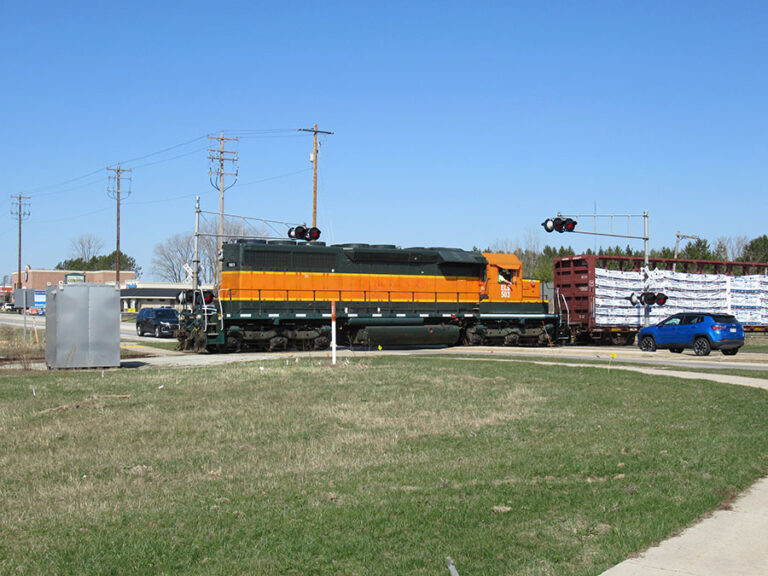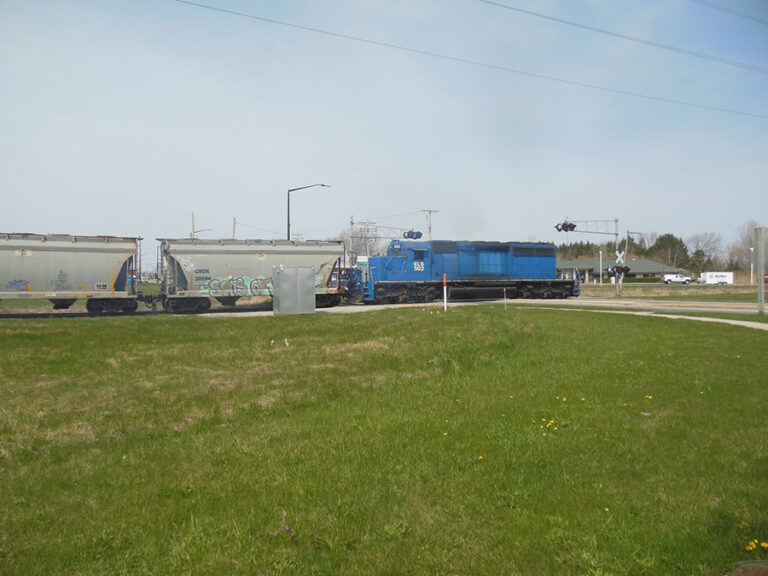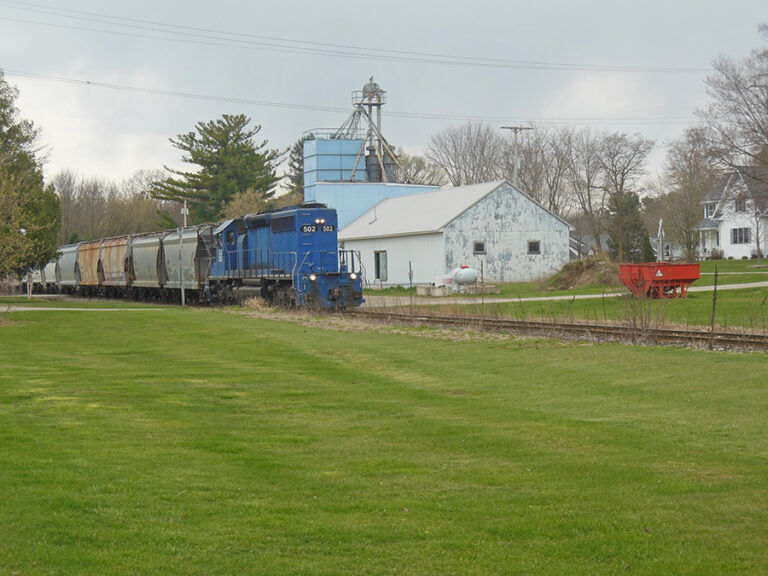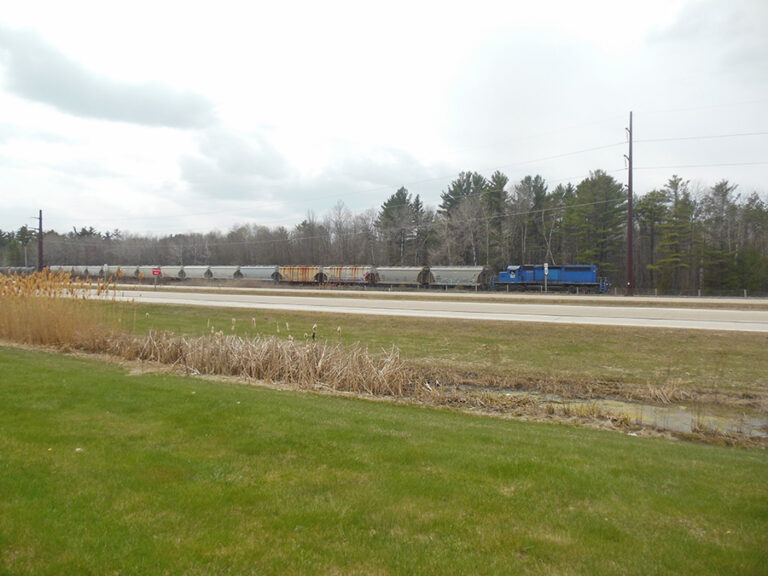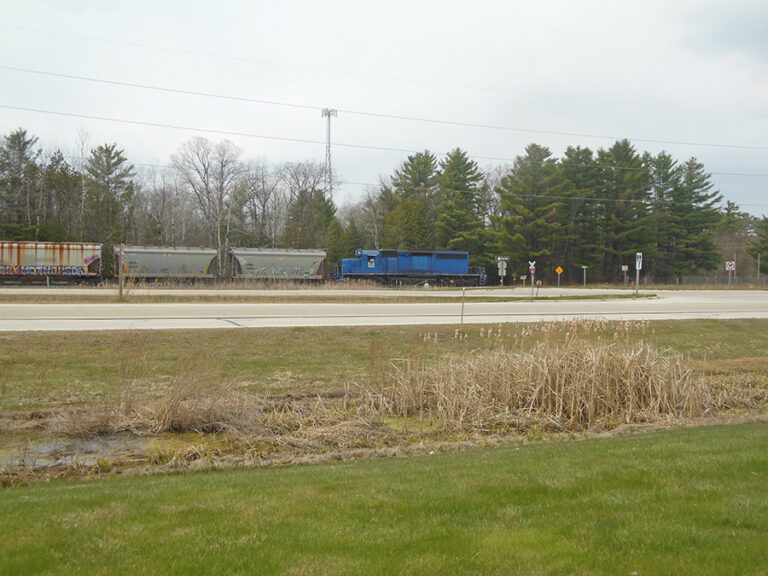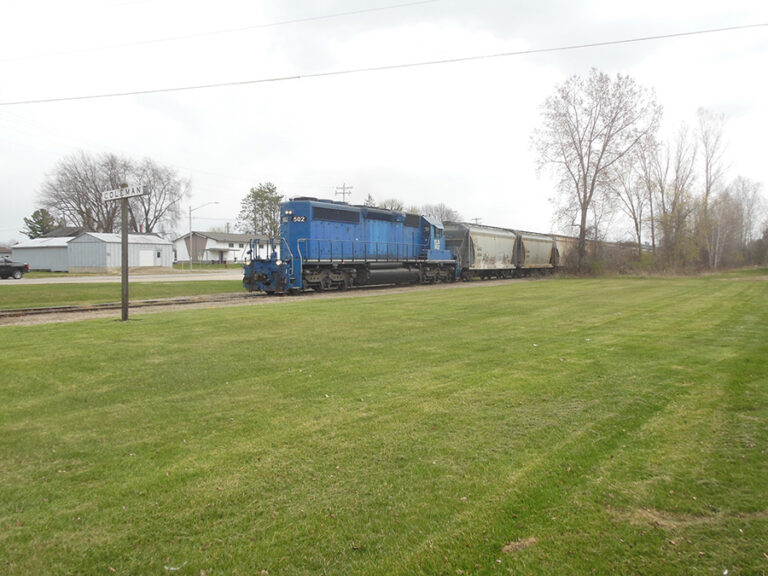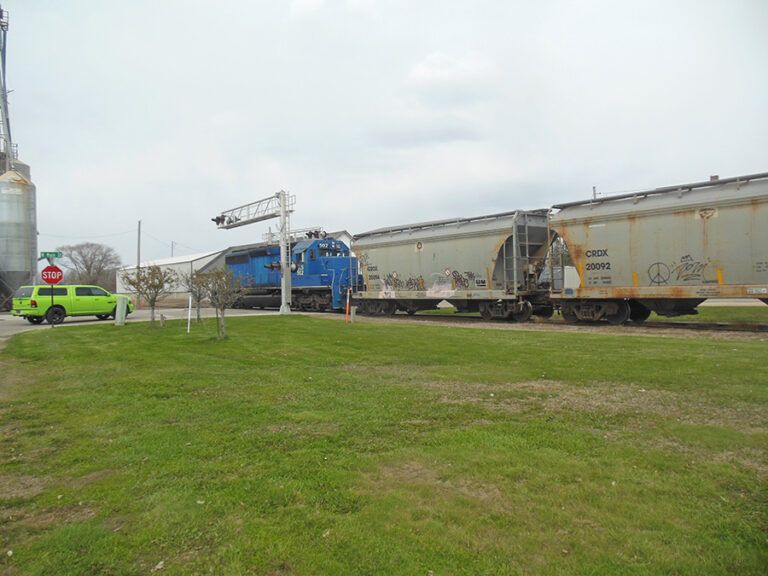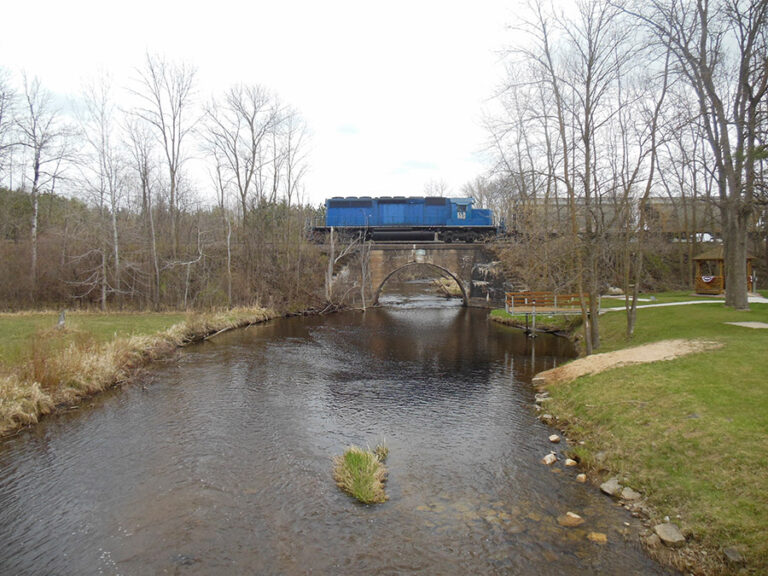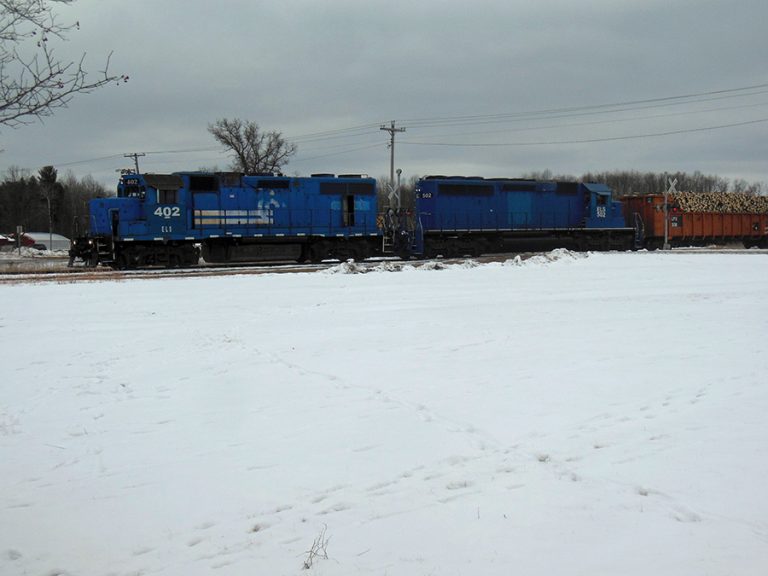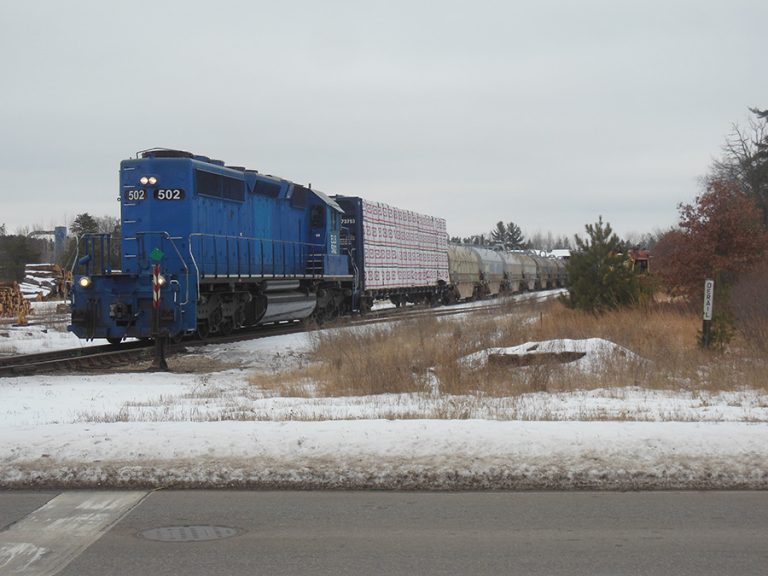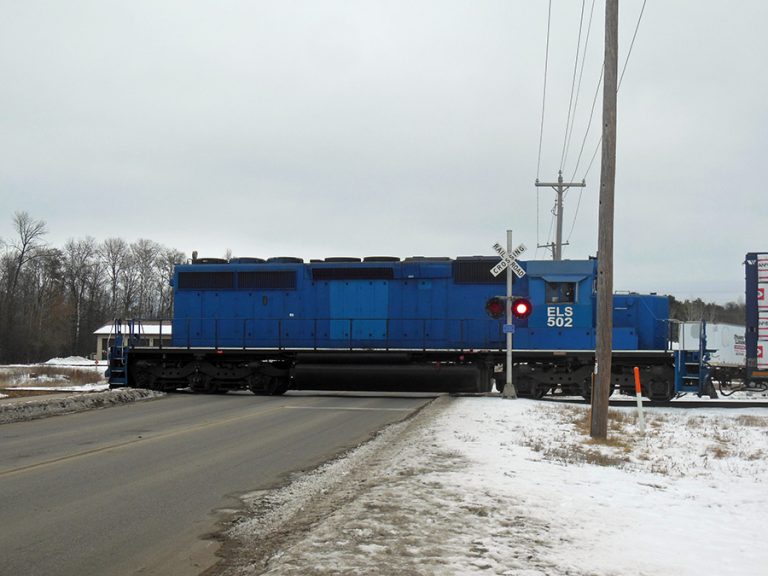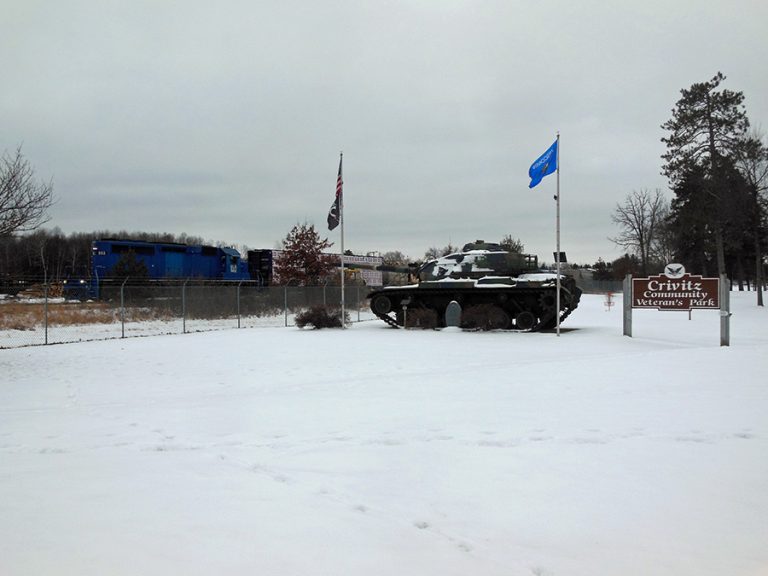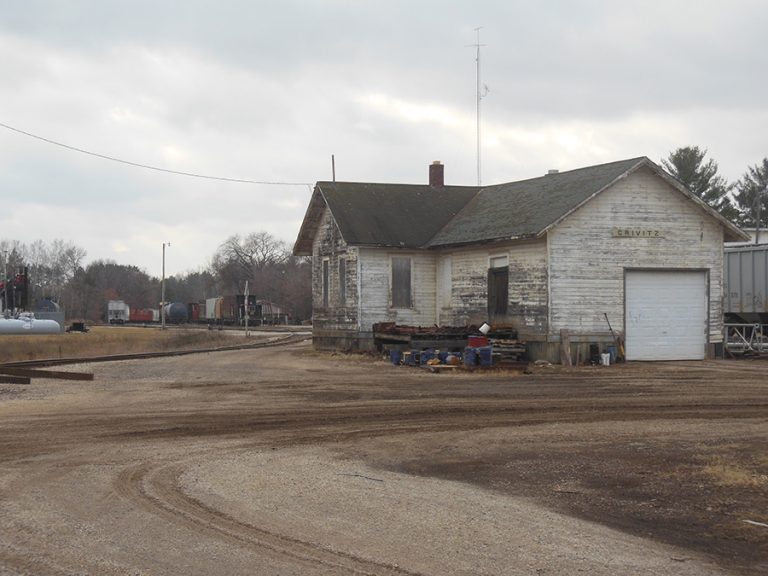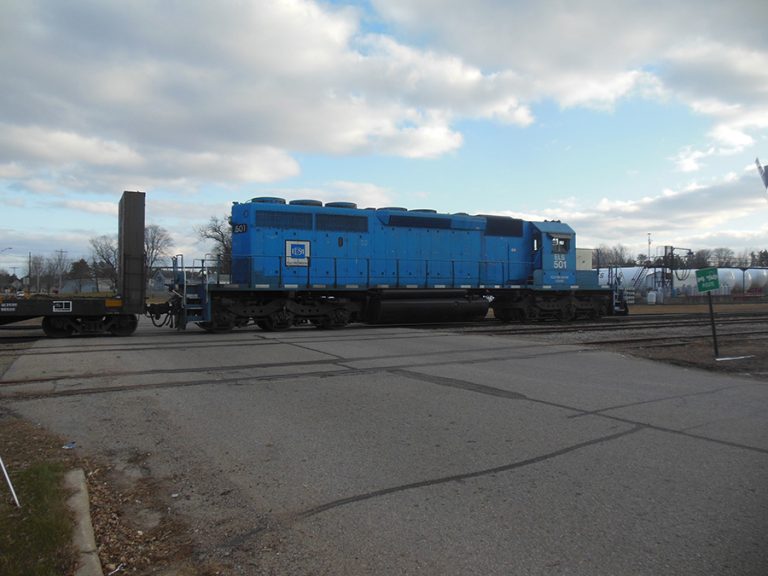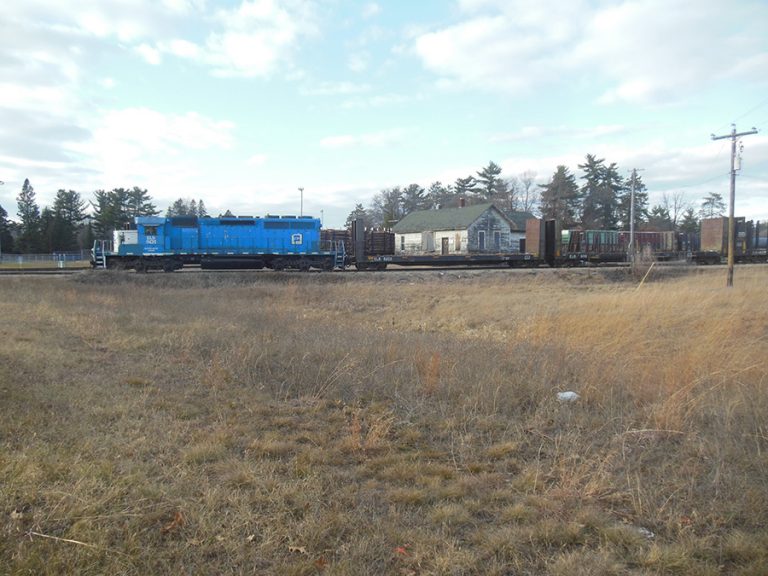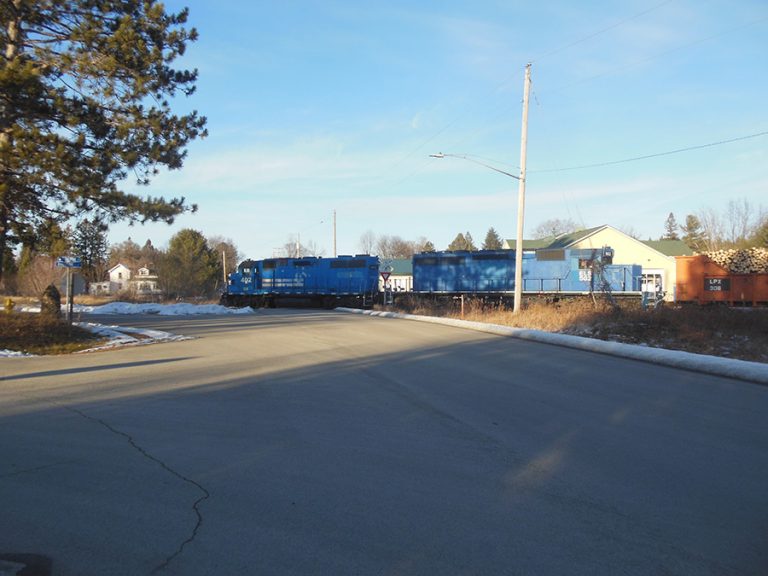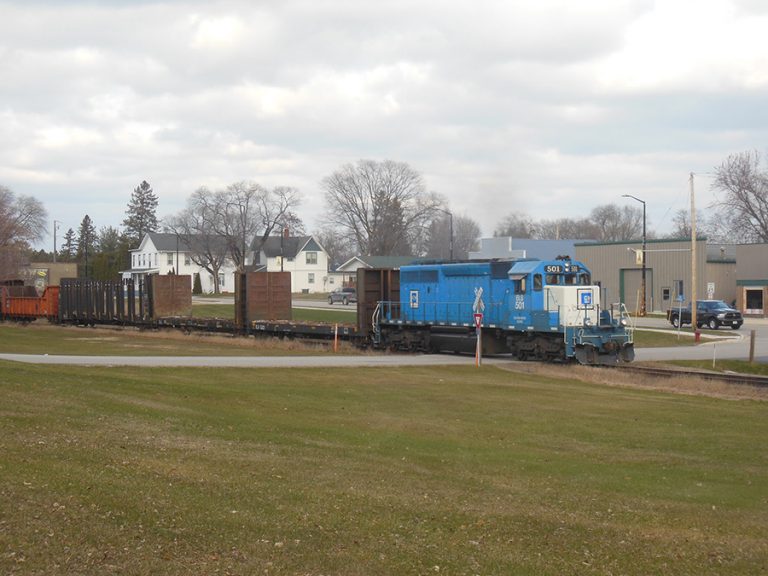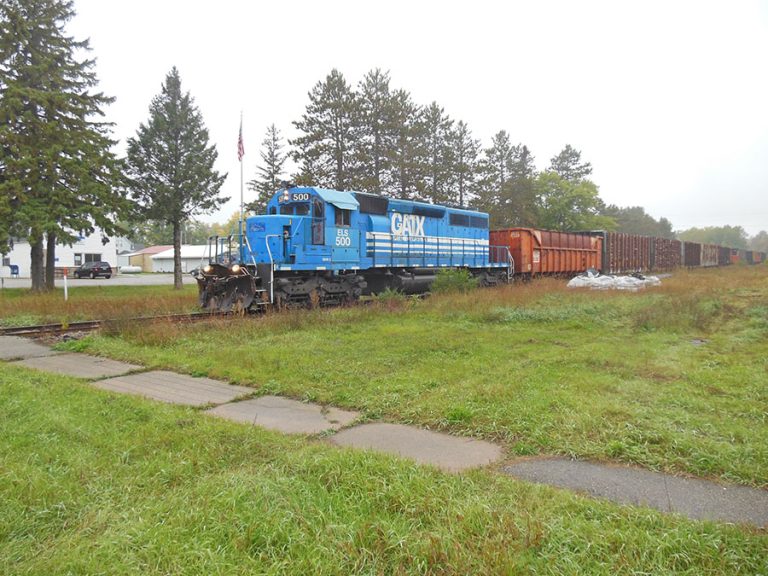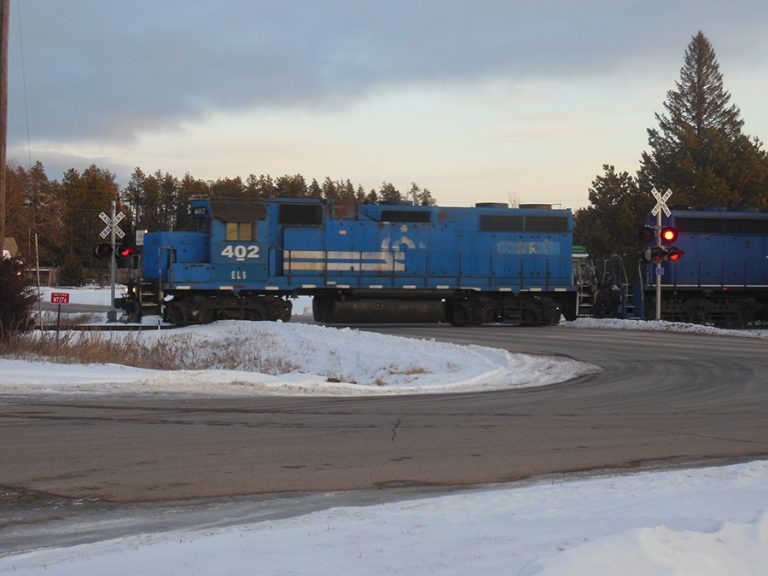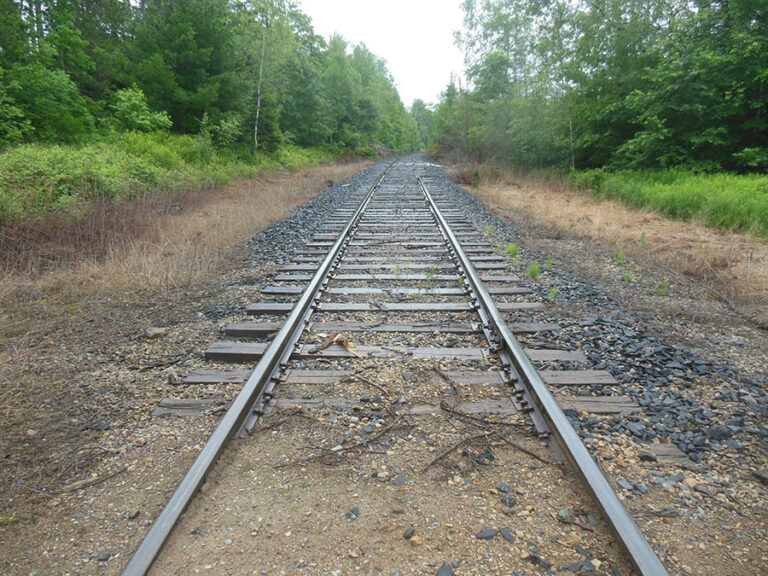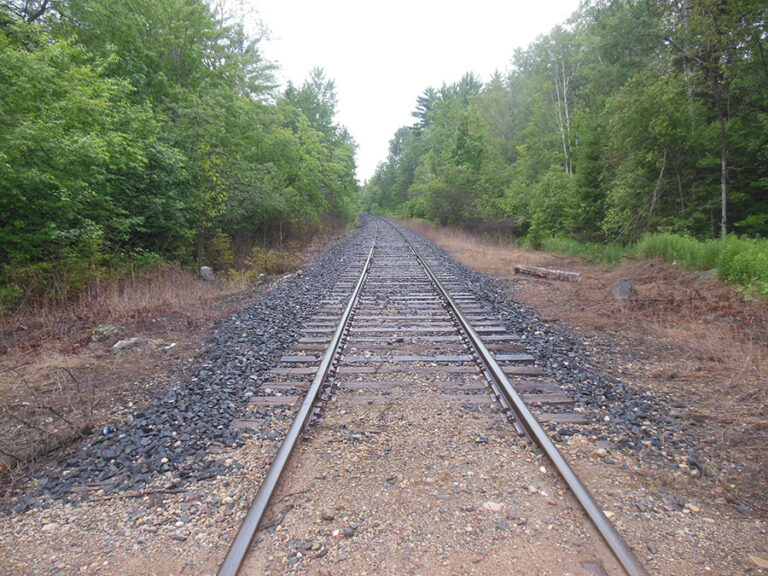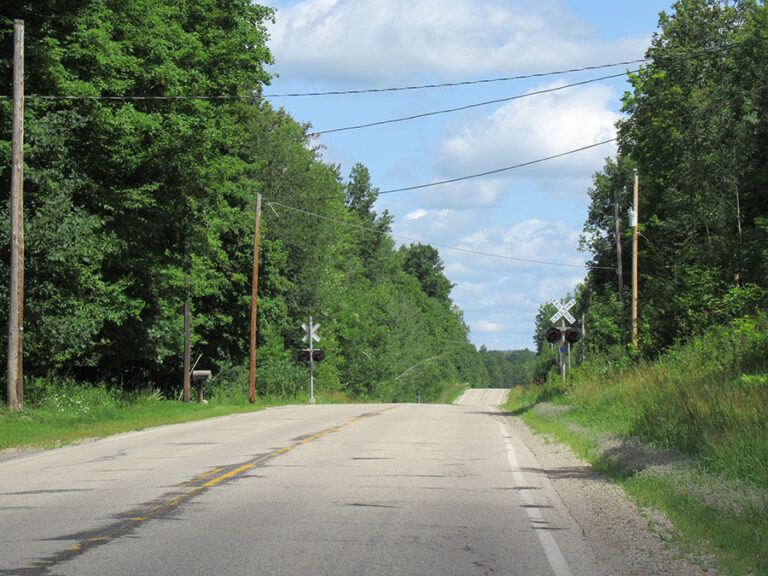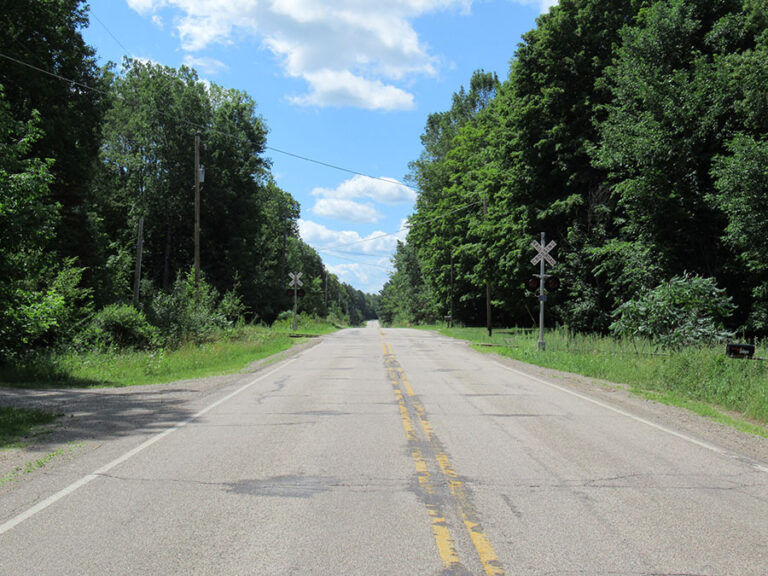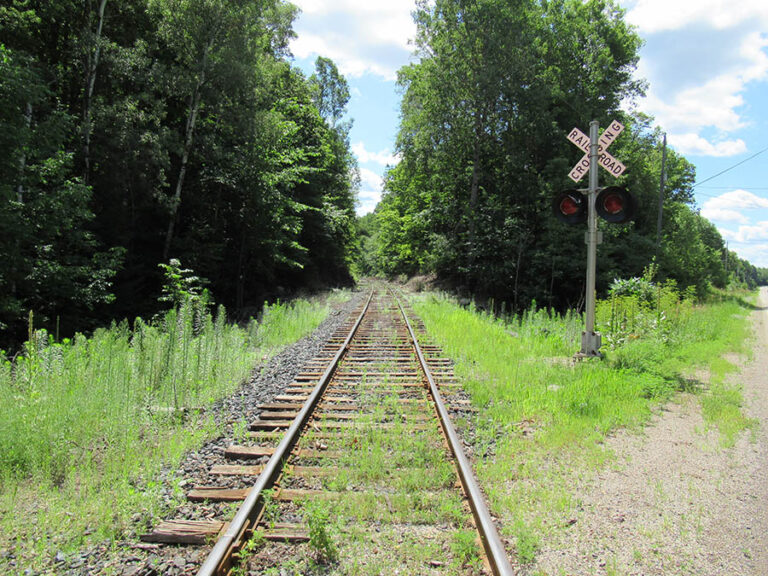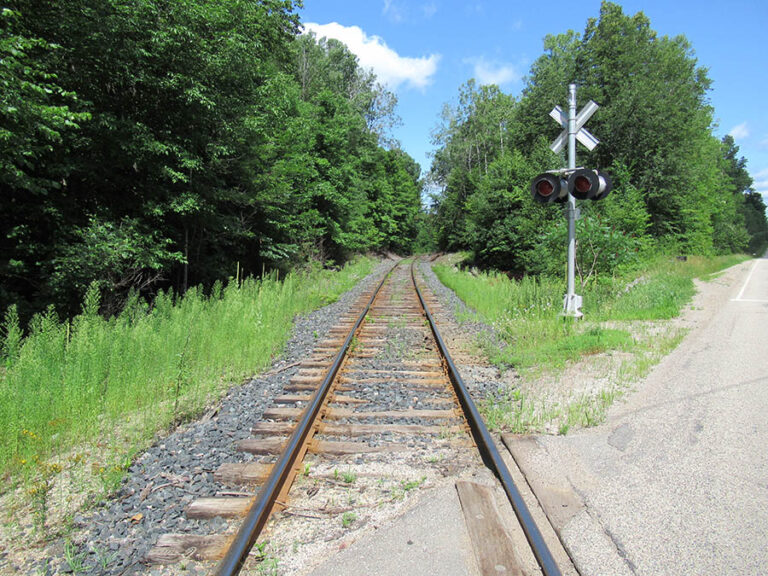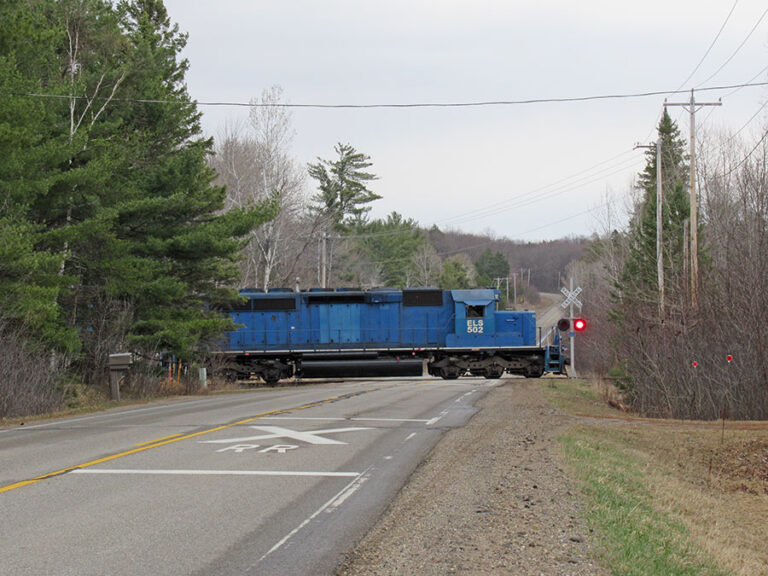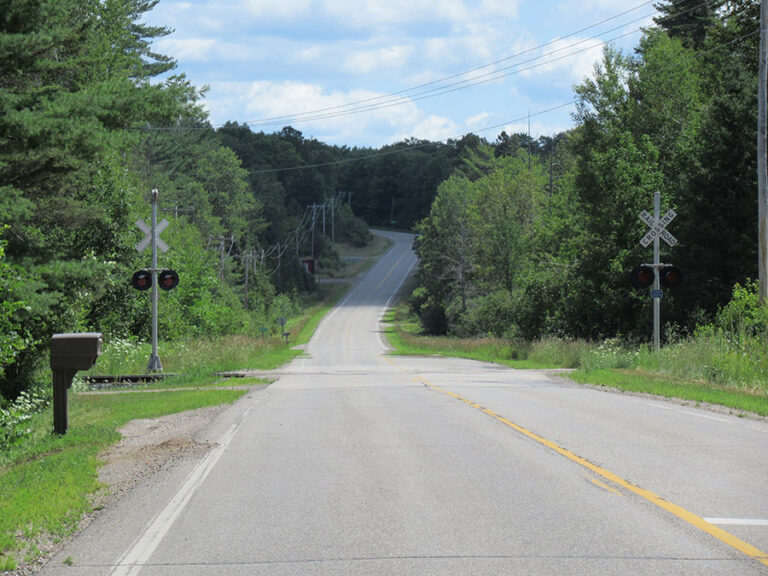Reminders of the Milwaukee & Northern Main Line - Fort Howard to the Menominee River
This portion of the M&N main line was constructed between 1874 and 1886.
It became the Superior Division of the Chicago, Milwaukee & St. Paul (CM&StP), or Milwaukee Road (MILW), on 1 July 1893. It reorganized as the Chicago, Milwaukee, St. Paul & Pacific (CMStP&P) in 1928.
Almost all of this portion of the former M&N main line is still active, operated by the Escanaba & Lake Superior (E&LS or ELS). The first three miles of this section, running from the Fox River to Bond St. in Green Bay, have been removed.
Cormier (Cormier Station), Wis., was Milepost 119 on the M&N.
Looking north along the former M&N main line from Glendale Ave. at Cormier (Cormier Station), Wis., on 28 October 2022. Cormier is now part of Howard, Wis. A couple of old maps depict the depot on the east side (right) of the main line, just north (beyond) the turnout for the passing siding. The M&N built a freight house here, to the left of the tracks, in 1889. It was razed circa September of 2013. Life Bridge Christian Church stands to the left. It was built on the former site of the Wheels n Motion roller skating rink. Photograph by Tom Bruss.
Looking north along the former M&N main line from Glendale Ave. at Cormier (Cormier Station), Wis., on 28 October 2022. Cormier is now part of Howard, Wis. A couple of old maps depict the depot on the east side (right) of the main line, just north (beyond) this turnout for the passing siding. In the distance, the bridge carrying the former Chicago & North Western (C&NW) right-of-way (now the Mountain Bay State Trail) over the former M&N can be seen. Photograph by Tom Bruss.
Howard, Wis., was not a station on the M&N. The portion of Howard where these photographs were captured would have been circa Milepost 121.
An E&LS train, led by ELS 502, crosses Velp Ave./Hwy. HS at Howard, Wis., on 23 April 2021. These rails were laid sometime after 1982 and connect the former M&N main line (just out-of-frame to the right) to the Canadian National (CN), former Chicago & North Western (C&NW), rails on the opposite (east) side of Howard Industrial Park. Photograph by Tom Bruss.
Suamico, Wis., was not a station on the M&N, but it would have been circa Milepost 122-3.
Tremble, Wis., was Milepost 124 on the M&N.
Sobieski, Wis., would have been circa Milepost 130 on the M&N.
Sobieski was not a station on the M&N. The station was established by the CM&StP, or MILW, in 1894.
Abrams, Wis., was Milepost 134 on the M&N.
Oconto Junction, Wis., was Milepost 137 on the M&N.
Looking north along the former M&N from E. Stiles Tower Rd. at Oconto Junction, Wis., on 26 July 2024. We believe the depot stood here on the north side of the road and the east side of the main line. The south leg of the wye paralleled the main line on the far side of the depot until it arced to the northeast to carry the Oconto Branch toward its namesake city. Photograph by Tom Bruss.
Looking south along the former M&N main line from E. Stiles Tower Rd. at Oconto Junction, Wis., on 26 July 2024. The turnout for the south leg of the wye was about 900 feet south of the road. That track paralleled the east side of the main line until it passed behind the depot and then arced to the northeast to carry the Oconto Branch toward its namesake city. Photograph by Tom Bruss.
Stiles, Wis., was Milepost 139 on the M&N.
Stiles Junction, Wis., was Milepost 141 on the M&N.
The station was listed as Grand Trunk Junction on an 1885 time table, because the intersecting line was laid by the St. Paul Eastern Grand Trunk Railway (StPEGT), operated by the Milwaukee, Lake Shore & Western (MLS&W), in 1882-3. The nearby community was originally known as Leightown, but was renamed Stiles Junction ca. 1882.
An E&LS train backs onto the former M&N main line from the remnant of the passing siding at Stiles Junction, Wis., on 20 August 2021. They have just returned from the Oconto Falls Branch, a remnant of the former Chicago & North Western (C&NW) main line. They will now pick up the rest of their train, left at Duame Rd., and continue north. The train is powered by ELS 502 and ELS 402. Photograph by Tom Bruss.
Lena (originally Maple Valley), Wis., was Milepost 146 on the M&N.
Coleman, Wis., was Milepost 153 on the M&N.
An E&LS train, led by ELS 502 and ELS 501, crosses Main St. and approaches the station sign as it heads southwest via the former M&N main line at Coleman, Wis., on 12 April 2024. According to a 1912 map, the depot stood right about here. It is always a treat to encounter a former MILW locomotive plying former MILW rails. Photograph by Tom Bruss.
An E&LS train, led by ELS 502, passes the station sign, parallels S. Railway Ave. and S. Franklin Ave., and approaches W. Main St./Hwy. B as it heads north with 21 cars via the former M&N main line at Coleman, Wis., on 23 April 2021. A 1912 map depicts the depot right about where the station sign is. Photograph by Tom Bruss.
An E&LS train, led by ELS 502, passes Veterans Park and crosses the Little Peshtigo River via a 1902 masonry/concrete arch bridge as it heads north with 18 cars via the former M&N main line at Coleman, Wis., on 23 April 2021. It had just set out a couple of cars at United Co-op. Photograph by Tom Bruss.
The E&LS, former Milwaukee Road (MILW), bridge over the Little Peshtigo River at Coleman, Wis., on 1 January 2021. The masonry/concrete arch bridge was built in 1902 for the MILW. A small community sprouted up near this bridge site in 1880, around the Waldron Dickinson Co. (later Marshall Holmes Co., later E. E. Bolles Co.) sawmill (which stood behind me on the opposite side of Bus. 141). The community was referred to as Little River, but is now part of Coleman. The railroad construction camp was located near this site. The Marshall Spur connected the sawmill to the M&N main line. The sawmill closed in 1911 after the local timber supply was exhausted. The locals have affixed a plaque claiming it to be the “Joseph Brault Memorial Bridge 1824-1887.” Joseph Urgel Brault is considered, by some, to be the founder of the Village of Coleman, Wis., in 1870, but doesn’t appear to have had anything to do with this bridge specifically or the railroad in general. Some references claim that the village was originally named Braultville and later changed to Coleman. Others claim that it has always been Coleman, named for a man who owned a lot of the land. Another reference asserts that Coleman and the neighboring village of Pound were named for US Representative Thaddeus Coleman Pound. He served on a committee which considered railroad land grants. One reference claims August Beaudry “to be the real founder of [Coleman].” He built a boarding house/store/saloon near the railroad right-of-way ca. 1881 as the railroad approached what is now Coleman. The original Brault settlement was about 2 miles east of Coleman, where Hwy. B crosses the Little Peshtigo River. Referred to as Braultville (some references claim officially, others unofficially), it has also been referred to as East Coleman. Photograph by Tom Bruss.
Pound, Wis., was Milepost 156 on the M&N.
Beaver, Wis., was Milepost 159 on the M&N.
Crivitz, Wis., was Milepost 165 on the M&N.
The station of Ellis Junction was established by the M&N in 1883, when this portion of the main line was completed. That same year, the post office of Crivitz was established in the village which had sprouted near the railroad station. The station name was still listed as Ellis Junction on a 1922 MILW time table, but a 1957 time table lists the station as Crivitz.
A pair of E&LS locomotives, ELS 501 and ELS 502, rest in the former M&N yard at Hall Ave., Crivitz, Wis., 12 April 2024. The crew was preparing to depart for Green Bay. ELS 501 was built in July of 1973 as MILW 22. It is always a treat to encounter a former MILW locomotive plying former MILW rails. Photograph by Tom Bruss.
The west and south walls of the former M&N depot at Crivitz, Wis, on 28 May 2015. We believe that this is the depot erected by the M&N when they reached Crivitz in 1883. That is, we haven’t found any indication that the original depot was replaced. It is currently used by the E&LS. Photograph by Tom Bruss.
ELS 402 and ELS 502 pass the former M&N depot as they work the yard at Crivitz (originally Ellis Junction), Wis., on 9 January 2021. I am nearly certain that this is the depot built by the M&N when the line was laid in 1883. That is, I haven’t found any indication that the original depot was replaced. Photograph by Tom Bruss.
ELS 502 approaches Henriette Ave. as it sorts cars at the former M&N yard at Crivitz (originally Ellis Junction), Wis., on 9 January 2021. The forlorn Derail sign to the right stands as a reminder that four tracks used to cross Henriette Ave. at this spot, these two tracks parallel to the west side of the main line as well as another one running parallel along the east side.
ELS 502 passes the former M&N depot as it sorts cars in the yard at Crivitz (originally Ellis Junction), Wis., on 9 January 2021. I am nearly certain that this is the depot built by the M&N when the line was laid in 1883. That is, I haven’t found any indication that the original depot was replaced. Photograph by Tom Bruss.
The west and south walls of the former M&N depot at Crivitz (originally Ellis Junction), Wis, on 1 January 2021. I am nearly certain that this is the depot built by the M&N when the line was laid in 1883. That is, I haven’t found any indication that the original depot was replaced. It is currently used by the E&LS. This is the southwestern corner of the large wye formed by the junction of the main line, running north-south in front of the depot, and the Menominee Branch running southeastward to Menominee, Mich., behind the depot. To the right, an E&LS train, led by ELS 402, rests on the south leg of the wye. The locomotive was idling and the headlights were on (dimmed), so I thought it was ready to go somewhere. Sadly, it was not to be. I like this scene because it almost looks like the train could be moving and approaching the depot. Photograph by Tom Bruss.
An E&LS train, led by ELS 402, rests on the south leg of the wye near the former M&N depot at Crivitz (originally Ellis Junction), Wis., on 1 January 2021. This is the southwestern corner of the large wye formed by the junction of the main line, running north-south in front of the depot, and the Menominee Branch running southeastward to Menominee, Mich., behind the depot. The locomotive was idling and the headlights were on (dimmed), so I thought it was ready to go somewhere. Sadly, it was not to be. In the background to the right, ELS 503 rests in the yard. The former M&N depot stands at the far right. I am nearly certain that this is the depot built by the M&N when the line was laid in 1883. That is, I haven’t found any indication that the original depot was replaced. Photograph by Tom Bruss.
The west and south walls of the former M&N depot at Crivitz (originally Ellis Junction), Wis, on 27 November 2020. I am nearly certain that this is the depot built by the M&N when the line was laid in 1883. That is, I haven’t found any indication that the original depot was replaced. It is currently used by the Escanaba & Lake Superior (E&LS or ELS). This is the southwestern corner of the large wye formed by the junction of the main line, running north-south in front of the depot, and the Menominee Branch running southeastward to Menominee, Mich., behind the depot. Photograph by Tom Bruss.
The south and east walls of the former M&N depot at Crivitz (originally Ellis Junction), Wis, on 27 November 2020. I am nearly certain that this is the depot built by the M&N when the line was laid in 1883. That is, I haven’t found any indication that the original depot was replaced. It is currently used by the Escanaba & Lake Superior (E&LS or ELS). This is the southwestern corner of the large wye formed by the junction of the main line, running north-south in front of the depot, and the Menominee Branch running southeastward to Menominee, Mich., behind the depot. Photograph by Tom Bruss.
The east and north walls of the former M&N depot at Crivitz (originally Ellis Junction), Wis, on 27 November 2020. I am nearly certain that this is the depot built by the M&N when the line was laid in 1883. That is, I haven’t found any indication that the original depot was replaced. It is currently used by the Escanaba & Lake Superior (E&LS or ELS). This is the southwestern corner of the large wye formed by the junction of the main line, running north-south in front of the depot, and the Menominee Branch running southeastward to Menominee, Mich., behind the depot. Photograph by Tom Bruss.
Looking north along the former M&N main line from Hall Ave. toward an approaching E&LS train at Crivitz (originally Ellis Junction), WI, on 27 November 2020. I am nearly certain that this is the depot built by the M&N when the line was laid in 1883. That is, I haven’t found any indication that the original depot was replaced. It is currently used by the E&LS. This is the southwestern corner of the large wye formed by the junction of the main line, running north-south in front of the depot, and the Menominee Branch running southeastward to Menominee, Mich., behind the depot. Photograph by Tom Bruss.
An E&LS train passes the former M&N depot at Crivitz (originally Ellis Junction), Wis., on 27 November 2020. The train is led by ELS 501, built in July of 1973 as Milwaukee Road MILW 22. It is a treat to encounter a former MILW locomotive plying former MILW rails. I am nearly certain that this is the depot built by the M&N when the line was laid in 1883. That is, I haven’t found any indication that the original depot was replaced. This is the southwestern corner of the large wye formed by the junction of the main line, running north-south in front of the depot, and the Menominee Branch running southeastward to Menominee, Mich., behind the depot. Photograph by Tom Bruss.
An E&LS train crosses Hall Ave. as it heads south via the former M&N main line at Crivitz (originally Ellis Junction), Wis., on 27 November 2020. The train is led by ELS 501, built in July of 1973 as Milwaukee Road MILW 22. It is a treat to encounter a former MILW locomotive plying former MILW rails. Photograph by Tom Bruss.
An E&LS train shoves a cut of cars past the former M&N depot at Crivitz (originally Ellis Junction), Wis., on 27 November 2020. The train is led by ELS 501, built in July of 1973 as Milwaukee Road MILW 22. It is a treat to encounter a former MILW locomotive plying former MILW rails. I am nearly certain that this is the depot built by the M&N when the line was laid in 1883. That is, I haven’t found any indication that the original depot was replaced. This is the southwestern corner of the large wye formed by the junction of the main line, running north-south in front of the depot, and the Menominee Branch running southeastward to Menominee, Mich., behind the depot. Photograph by Tom Bruss.
An E&LS train shoves a cut of cars past Spur St. at the former M&N yard at Crivitz (originally Ellis Junction), Wis., on 27 November 2020. The train is led by ELS 501, built in July of 1973 as Milwaukee Road MILW 22. It is a treat to encounter a former MILW locomotive plying former MILW rails. This is the southwestern corner of the large wye formed by the junction of the main line, running north-south in front of the depot, and the Menominee Branch running southeastward to Menominee, Mich., behind the depot. Photograph by Tom Bruss.
Middle Inlet, Wis., was Milepost 169 on the M&N.
Wausaukee, Wis., was Milepost 176 on the M&N.
An E&LS train parallels Main St. (originally E. Railroad St.)/Hwy. 141 and crosses Monroe Ave. as it pulls 32 cars south via the former M&N main line at Wausaukee, Wis., on 27 November 2020. The train is led by ELS 501, built in July of 1973 as Milwaukee Road MILW 22. It is a treat to encounter a former MILW locomotive plying former MILW rails. The interesting, old, white building partially visible beyond the second bulkhead flatcar and adjoining pulpwood car is the historic Hotel Wausaukee. Erected in 1889, many M&N, and later MILW, passengers undoubtedly stayed there. Extensively altered over the years, it is currently home to Graphic Impressions Photography. An ice house once stood between the train and Main St./Hwy. 141. If the depot still stood, it would probably be partially visible at the right edge of the scene. It stood west of the rails south of Monroe Ave. At least one internet reference states the depot still exists, in private ownership. Either their information is not current or the depot has been moved. An awesome view of this scene from 1976 can be found at: http://rrpicturearchives.net/showPicture.aspx?id=5431528. Photograph by Tom Bruss.
Amberg, Wis., was Milepost 185 on the M&N.
Originally known as Station 3790, the name was soon changed to Pike, Wis. The name of the community was changed to Amberg in 1890.
An E&LS train crosses Amberg Rd. as it pulls 32 cars southeast via the former M&N main line at Amberg, Wis., on 27 November 2020. The train is led by ELS 501, built in July of 1973 as MILW 22. It is a treat to encounter a former MILW locomotive plying former MILW rails. The depot stood east (right) of the main line on the north side of Coleman Ave. It has been moved to the Amberg Museum Complex, about 2-1/2 blocks to the southwest. Part of the Mathis Hardware & Lumber, Inc., facility stands to the right. The business dates to December of 1946, when James D. Mathis established a hardware and feed store here. The company is currently owned and managed by his son and grandson. The facility used to receive rail service, but it doesn’t look like it has for quite a while. Photograph by Tom Bruss.
An E&LS train approaches Coleman Rd. as it pulls 32 cars southeast via the former M&N main line at Amberg, Wis., on 27 November 2020. The train is led by ELS 501, built in July of 1973 as MILW 22. It is a treat to encounter a former MILW locomotive plying former MILW rails. The depot stood east (right) of the main line on the north side of Coleman Ave. It has been moved to the Amberg Museum Complex, about 2-1/2 blocks to the southwest. Photograph by Tom Bruss.
An E&LS train passes the former site of the M&N depot and approaches Coleman St./Hwy. V as it pulls 54 cars southeast at Amberg, Wis., on 1 October 2014. The train is led by ELS 500 built in 1974 as MILW 182. It is a treat to encounter a former MILW locomotive plying former MILW rails. The depot stood here, to the right of the train. It has been moved to the Amberg Museum Complex, about 2-1/2 blocks to the southwest. Photograph by Tom Bruss.
Pembine Junction, Wis., was Milepost 193 (194 on some time tables) on the M&N.
An E&LS train crosses the junction with the CN, former SOO, rails as it heads northeast with 16 cars via the former M&N main line at Pembine, Wis., on 23 July 2021. The train was led by ELS 501, originally MILW 22. It is awesome to encounter a former MILW locomotive plying former MILW rails. The ca. 1887 union depot would have partially obscured this view of the train, until it was wantonly destroyed by arson perpetrated by juvenile miscreants on 17 June 2019. Photograph by Tom Bruss.
An E&LS train, led by ELS 402 and ELS 502, crosses Hwy. 8 as it heads northeast with 26 cars via the former M&N main line at Pembine, Wis., on 9 January 2021. Seeing as the sun made an unexpected, albeit brief, late afternoon appearance, I wanted to carefully choose a spot to shoot this train. Unfortunately, this E&LS crew reached Pembine before I could make up my mind. My only option was this spray-and-pray shot from the parking lot of the BP station, where I made a pit stop to purchase the (hopefully) winning ticket for the Powerball drawing that night. Needless to say, that was also a failure. Photograph by Tom Bruss.
Brown’s Spur, Wis., would have been circa Milepost 199 on the M&N.
We haven’t found Brown’s Spur, listed as a station on the M&N. Sometimes listed as Browns Spur, Brown’s Station, Browns Station, or simply Browns, it was a station on the CM&StP, or MILW, from at least 1901 until at least 1938 according to some old maps and other references.
Summit Station, Wis., would have been circa Milepost 202 on the M&N.
We haven’t found Summit Station listed as a station on the M&N. Sometimes listed as Summit, or the Summit, it was a station on the CM&StP, or MILW, from at least 1894 until at least 1923 according to some old maps.
Anderson’s Spur, Wis., would have been circa Milepost 205 on the M&N.
We haven’t found Anderson’s Spur, listed as a station on the M&N. Sometimes listed as Andersons Spur, Anderson Spur, or Andersons, it was a station on the CM&StP, or MILW, from at least 1898 until at least 1938 according to some old maps and other references.

